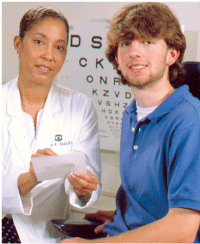 Q: Im trying to create a contact lens fitting policy in my practice, but Im having trouble deciding on an appropriate age cut-off. How can I judge if my younger patients will properly care for their lenses?
Q: Im trying to create a contact lens fitting policy in my practice, but Im having trouble deciding on an appropriate age cut-off. How can I judge if my younger patients will properly care for their lenses?
A: I really hate the term age-appropriate, says Jeffrey J. Walline, O.D., of the Ohio State University College of Optometry. Some six-year-olds are capable of independent lens care, and some 25-year-olds arent. I prefer indicators that are more appropriate than age for determining someones ability to care for contact lenses.
Note the childs behavior during the exam, says Marjorie J. Rah, O.D., of the New England College of Optometry. Watch how responsive the child is to questions and instructions. Try to gauge the childs maturity level and get an idea of the personal hygiene of the child.
Indicators of poor hygiene include long, dirty fingernails and messy, greasy hair. Ask parents about the childs routine, adds Dr. Walline.
Judge the childs motivation by his or her ability to insert and remove the lenses, suggests Dr. Rah. One of my biggest rules for fitting elective contact lenses is that the child has to be able to apply and remove the lenses by him- or herself, she says. This ensures that the patient is less likely to have difficulty at home, and it also helps sort out which children are truly motivated to wear the lenses. Some decide that they would prefer to wear their [spectacle] lenses.
Also, consider the parents, says Dr. Rah. If parents do too much for their children, it may be a red flag for contact lens fitting. Such children dont learn to insert, remove and care for lenses themselves, explains Dr. Walline.
But, Dr. Rah adds, parents shouldnt be too hands-off. You want a child who is able to care for the lenses independently with a parent who is monitoring the process.
Fit younger patients with daily disposable lenses. Routine is very important to children, says Dr. Walline. When it is broken, theyre less likely to fully clean their lenses. Dr. Rah explains: The use of daily disposable lenses eliminates the daily cleaning regimen. It puts parents mind at ease, knowing that the child will have clean lenses.

Even when managing teenage patients, thoroughly explain the lens care regimen to themperhaps in writing.
When fitting any lens modality, make sure (just as you do with older patients) that children follow the care regimen. Ask them how they care for the lenses and whether they sleep, shower or swim in them, says Dr. Rah. We have used true/ false tests in research to assess compliance; this is a great way to discuss the issue with children.
Create such questions from your interactions with young patients, says Dr. Walline. Ask what they do in the event of problems.
Schedule a follow-up with your young patients one week later to evaluate their ability to insert and remove their lenses, he adds.
Gender may also play a role in young patients success with lens wear; anecdotal reports demonstrate increased ability and motivation among younger girls.
Studies have measured some effects of juvenile lens wear, such as ocular health over the course of lens wear or its impact on quality of life.1,2 In one, children had the same rate of success with lens wear as did teenswhich is to say, neither group experienced any complications secondary to lens wear.1
In another study, quality of life changes as a result of lens wear were similar between teens and children.2
Children have been as successful as adults with every modality weve tested, says Dr. Walline.
1. Walline JJ, Jones LA, Rah MJ, et al. Contact Lenses in Pediatrics (CLIP) study: chair time and ocular health. Optom Vis Sci 2007 Sep;84(9):896-902.

